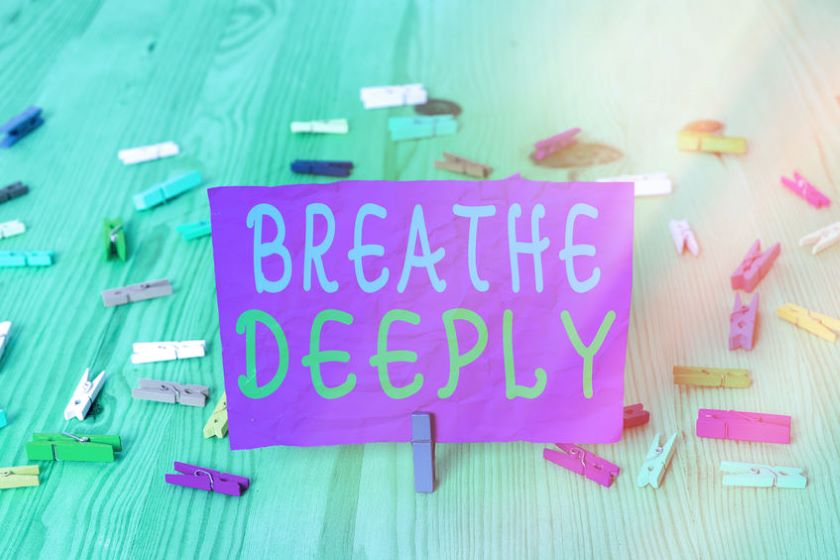Heart coherence to better manage stress?
It's in the air, like a new societal trend. If back pain was considered until not so long ago as the "disease of the century," it seems times have changed, as they say. Out of breath, maybe it's time for us to take the time to breathe better in order to fight stress, the new inherent ailment of a "hyperconnected" era that lives at full speed but ultimately not really in tune with the "self."
A new generation of women and men therefore wants to take control. Let Mother Nature and our own nature reclaim their rights. In short, return to the essentials: find well-being.
No more junk food, stop overconsumption. Earthling 3.0 wants to consume better (hello organic and second-hand), but above all to put a stop to the frantic pace of life that is being imposed, as well as its harmful consequences for health. What if the quest for well-being was our new Eldorado? How to fight everyday stress? The answer may lie within us and around us, invisible, like a breeze that caresses our skin.
What if breathing was the foundation of well-being and could help us reduce stress? If you want to make the saying "a healthy mind in a healthy body" your own, dear night rebels, we offer you a little focus on stress management through heart coherence, with everything you need to know about this breathing method, and our famous "hacking tips." Living better and sleeping better is sometimes as simple as breathing... thanks to a breathtaking technique!

What is cardiac coherence?
You probably know what coherence and the heart are. However, do you really know what cardiac coherence corresponds to? Here, the heart has its reasons that the brain and breathing cannot ignore.
I breathe, therefore I am
Cardiac coherence is a breathing technique aimed at mastering one's breathing in order to better control emotions, especially stress or anxiety. This regulation of emotions is made possible through the synchronization of the activity of the sympathetic nervous system ("SNS"), responsible for certain automatic activities of the body (such as heart rate), and the activity of the parasympathetic nervous system ("PNS"), which is in charge of controlling involuntary activities of organs, glands, or blood vessels. Moreover, the PNS has a "cardio-moderating" role, meaning it can reduce the heart rate.
The heart and breathing are essential to the proper functioning of the "autonomic nervous system," responsible for all regulation of our body. It is composed of the SNS and the PNS, two subsystems we just mentioned. The good health of the body, and of our autonomic nervous system in particular, actually lies in the proper balance between the sympathetic and parasympathetic nervous systems. If these two systems are balanced and coherent with each other, we feel good! It seems simple, doesn't it?
Now, curious as you are, you are probably wondering how one can achieve this balance leading to well-being? Rest assured, this is easier to restore than the balance of the "Force" in Star Wars!
Like a young padawan, be attentive to find balance in cardiac coherence.
Breathe… you did it!
The balance of the autonomic nervous system depends on the heart rate variability ("HRV"). HRV therefore corresponds to the degree of fluctuation in the duration of heart contractions, or the interval between two contractions. A high HRV is a sign of good regulation of heart rate according to needs (this is often the case in athletes). Heart rate variability is, in a way, a reflection of the state of our nervous system: if it is high, it means the nervous system adapts quickly to the individual's environment and the needs it generates.
Thus, it is the HRV, or rather its ability to adapt, that links the sympathetic and parasympathetic: breathing is therefore the lever that allows us to influence our autonomic nervous system.
To explain this, one could imagine that the central nervous system ("CNS") is on "autopilot" and reacts on our behalf to the events we face and what we experience, potentially creating stress or anxiety. Thus, mastering your breathing is to activate this famous lever that will allow us to regain control over the CNS, by lowering the heart rate.
Florence Servan-Schreiber, a recognized specialist in positive psychology, describes cardiac coherence as "a breathing technique that resets your nervous system. It helps you calm down, relax, and rest. We are in constant tension between two systems: the sympathetic, which speeds up, and the parasympathetic, which slows down." To simplify, let's say:
- With each inhalation: activation of the sympathetic nervous system and increase in heart rate
- With each exhalation: activation of the parasympathetic nervous system and decrease in heart rate, slowing of the heart
Thus, when we find ourselves in a situation of anxiety or in a period of stress that has been ongoing for some time, these states will disrupt our heart rate variability. From then on, modifying our breathing through adapted exercises will allow readjusting HRV and restoring the balance between sympathetic and parasympathetic to the right equilibrium: we then regain a state of well-being! Magical, isn't it?
As you can see, dear night rebels, sometimes you don't have to overcomplicate things to feel good. Simple breathing exercises, accessible to everyone, it was a clever idea, but also understanding this mechanism and the link between heart rate, breathing, and the autonomic nervous system. By the way, do you know to whom we owe this famous cardiac coherence?
A truly new trend?
Cardiac coherence, although currently very popular, is actually not that new. On the contrary. It is in fact just a (good) remake of much older relaxation techniques, but in tune with its time: simple, playful, and effective. Developed in the modern era from the late 90s in the USA (naturally, to make a good remake, they know how to do it!), and popularized by Stephen Elliot and his "Coherent Breathing," cardiac coherence and its health benefits are now scientifically recognized.
In France, it is Professor David Servan-Schreiber, doctor, research director, and scientific writer, who popularized the concept of cardiac coherence1, notably through his literary works (Guérir, Robert Laffont editions, 2003) or his numerous scientific publications, which we highly recommend you read.
A little historical and cultural note: there are already references to heart rate variability and related breathing studies in the manual Huangdi Nei Jing ("Inner Classic of the Yellow Emperor"), which is the oldest traditional Chinese medicine book. It dates back to the 5th century BC. When we told you cardiac coherence wasn't such a new trend!
Now that you know (almost) everything about the principles of cardiac coherence, you are surely eager to try it. Practicing cardiac coherence is simple. Really. You just need the right tips and good guidance.
You're in luck, dear night rebels, because here at Sleep Hackademy, we know a thing or two about well-being and sleep!
Cardiac coherence for dummies: the hacking tips from Sleep Hackademy
No, you're not bad. It was just a little reference to those manuals aimed at people wanting to better master a subject (yes, the web isn't the only place to learn things!). What we really want is to offer you a small selection of good practices to fight stress. These tips to overcome anxiety or stress are our famous hacking tips (or "hacking advice," for the poor English students), found within Sleep Hackademy and in our newsletters.
Join up, they said!
No panic, compulsory military service is not being reinstated! However, we offer you to enjoy a cardiac coherence exercise straight from the USA (yes, them again!) and used by... the American army. We want you!
The "Combat Tactical Breathing," despite its name, is more of a "Peace and Love" relaxation and concentration technique. And that's why it's useful and used by military personnel in combat stress situations, but also for us, in daily life (which can sometimes feel like an obstacle course, it's true). So, what exactly is Combat Tactical Breathing? It's as simple as counting to 4, proof:
- Take a deep breath counting to 4, visualizing each number: 1, 2, 3, 4.
- Hold your breath for 4 seconds while visualizing each number: 1, 2, 3, 4.
- Exhale and empty as much air as possible from your lungs, visualizing each number: 1, 2, 3, 4.

As you can see, it’s really easy as pie. This little exercise can be done anywhere, anytime. Ideally, practice this Combat Tactical Breathing cycle 3 to 5 times, several times a day.
Fancy a 365?
Yes, more numbers! One wonders if cardiac coherence and mathematics haven't made a secret alliance. So, the “three six five,” what is it? Let's say it is close in principle to the Combat Tactical Breathing mentioned earlier, except that it uses different measures: 3 times a day, 6 breaths per minute, for 5 minutes.
The goal of this exercise is really to have the slowest possible breathing. If the pace of 6 breaths per minute is too difficult to maintain at first, it is of course possible to increase the rates of inhalations and exhalations. As in many fields, practice is needed to improve! With training, it will be all the easier for you to enter cardiac coherence and thus feel at your best, mentally and physically. Here is our 365 tip:
- Sit with your back straight, your feet flat on the floor, and your hands on your knees
- Place one hand on your heart while closing your eyes, focus on its beats
- Inhale for 5 seconds, then exhale for 5 seconds, repeating this deep breathing 6 times (one minute in total)
- Do 5 cycles (that is 5 minutes in total) to achieve the beginning of cardiac coherence
- Repeat the exercise 3 times a day (or even 4 times if your day extends)
There are many breathing techniques of this type. If you are interested in the subject, you can discover more through videos made by our Sleep Hackers.
What are the benefits of cardiac coherence?
You have probably noticed, the practice of cardiac coherence is as simple as can be. The key is to let go for a few moments during your day, and to be as consistent as possible in doing these little breathing exercises. And we are sure you will do it once you notice the beneficial effects after just a few days of practice.
We can already offer you a little preview of what this breathing technique can bring you, free and simple:
- It's good for the mood! (and it may have inspired a famous song)
- Reduction of cortisol levels (defense hormone secreted during stress)
- Reduction of high blood pressure
- Reduction of cardiovascular disease risks
- Better regulation of blood sugar levels
- Improvement of concentration and memory
So here is a brief overview of the potential benefits related to the practice of heart coherence, recognized by scientists in numerous studies2. So, it's worth (better) breathing, isn't it?
As mentioned earlier, the practice of heart coherence is not new. It is therefore interesting to draw a parallel with breathing techniques associated with meditative practices, such as pranayama. This particular breathing technique of yoga was the subject of a scientific study in 20203, which consisted of analyzing and measuring (using MRI) the responses of brain areas "in charge" of stress and anxiety to emotionally impactful situations, before and after the pranayama breathing practice. The verdict? It is unequivocal, as with other studies of the same type:
- Modulation of the activity of brain regions involved in emotion processing (anterior cingulate, anterior insula, amygdala, prefrontal cortex)
- Decrease in anxiety level (State-Trait Anxiety Inventory, that is the "STAI")
- Better affect (measured with the « Positive Affect and Negative Affect Scale »)

We can therefore conclude that yoga is also "good for the mood," even cats approve!
We know that if you are visiting Sleep Hackademy, dear night rebels, it is very likely that you are interested in sleep, and/or that you suffer from sleep disorders. What if we told you that heart coherence can be beneficial for your sleep?
Heart coherence to fight insomnia?
Stress is one of the main causes of insomnia. Reducing your stress or anxiety means giving yourself a better chance to sleep well and have restorative sleep. This is a scientifically established fact.
Within Sleep Hackademy, we really love Dodow. And for good reason, this small, playful, and clever device is a great ally to find good heart coherence to fall asleep more easily. How does it work?
Dodow is simply a small cardiac coherence exercise based on a luminous visual. This little magic pebble projects a light that changes intensity, in order to capture the attention of the nocturnal rebel, who no longer focuses on his intrusive thoughts that prevent him from falling asleep. The breathing synchronizes with the light emitted by Dodow, thus causing a slowing down of the metabolism thanks to cardiac coherence: you then find yourself in good conditions to find your precious sleep.
Vous souhaitez en savoir plus ? Suivez ce lien et découvrez une application aussi lumineuse que ludique pour la gestion du stress par la cohérence cardiaque, grâce à Dodow ! 
Cardiac coherence is a trend, but it should not be considered just a passing fad, especially if you want to feel better in your mind and body. The benefits of cardiac coherence are scientifically proven, and the simplicity of its practice has everything to appeal to a society eager for connection, speed, and profitability at all costs.
Well-being in a few breaths blows away stress and chases it off, leaving us with a new motto that could be written as "I breathe well, therefore I feel good." A word to the inveterate romantics! To stay on the theme of breathing, we offer you a little musical treat, signed by Eddie Vedder (singer of the band Pearl Jam), entitled "Just Breath", reminding us that love is also breathed...
Sources:
[1] Cardiac Coherence: if your heart tells you so!, Dr. Laurence Benedetti et al, dossier "Les échos de la micronutrition", site "Institut Européen de la Micronutrition", 1999 [2] Cardiac coherence, self-regulation, autonomic stability, and psychosocial well-being,Rollin McCraty, Maria A. Zayas, "Frontiers in Psychology", 2014 [3] Effects of Yoga Respiratory Practice (Bhastrika pranayama) on Anxiety, Affect, and Brain Functional Connectivity and Activity: A Randomized Controlled Trial, Morgana M. Novaes, Fernanda Palhano-Fontes et al, "Frontiers in Psychiatry", 2020
